Financial Decision Making
VerifiedAdded on 2023/01/11
|14
|4055
|20
AI Summary
This report discusses the meaning and importance of the accounting and finance department in Morrisons, a leading supermarket chain in the UK. It also evaluates the roles of each department and analyzes the financial position and performance of ALPHA Ltd. based on its financial ratios.
Contribute Materials
Your contribution can guide someone’s learning journey. Share your
documents today.

Financial Decision Making
Secure Best Marks with AI Grader
Need help grading? Try our AI Grader for instant feedback on your assignments.
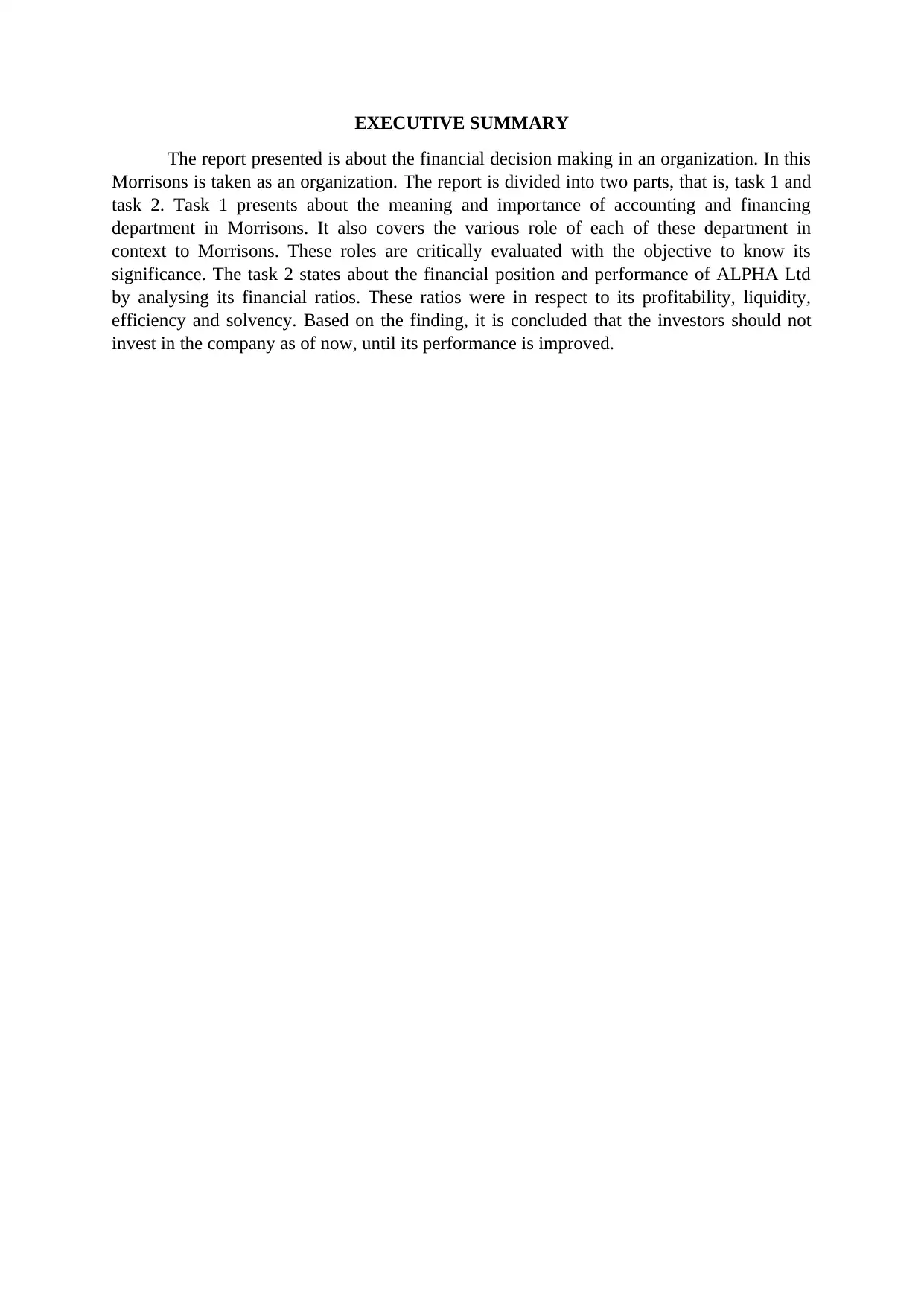
EXECUTIVE SUMMARY
The report presented is about the financial decision making in an organization. In this
Morrisons is taken as an organization. The report is divided into two parts, that is, task 1 and
task 2. Task 1 presents about the meaning and importance of accounting and financing
department in Morrisons. It also covers the various role of each of these department in
context to Morrisons. These roles are critically evaluated with the objective to know its
significance. The task 2 states about the financial position and performance of ALPHA Ltd
by analysing its financial ratios. These ratios were in respect to its profitability, liquidity,
efficiency and solvency. Based on the finding, it is concluded that the investors should not
invest in the company as of now, until its performance is improved.
The report presented is about the financial decision making in an organization. In this
Morrisons is taken as an organization. The report is divided into two parts, that is, task 1 and
task 2. Task 1 presents about the meaning and importance of accounting and financing
department in Morrisons. It also covers the various role of each of these department in
context to Morrisons. These roles are critically evaluated with the objective to know its
significance. The task 2 states about the financial position and performance of ALPHA Ltd
by analysing its financial ratios. These ratios were in respect to its profitability, liquidity,
efficiency and solvency. Based on the finding, it is concluded that the investors should not
invest in the company as of now, until its performance is improved.
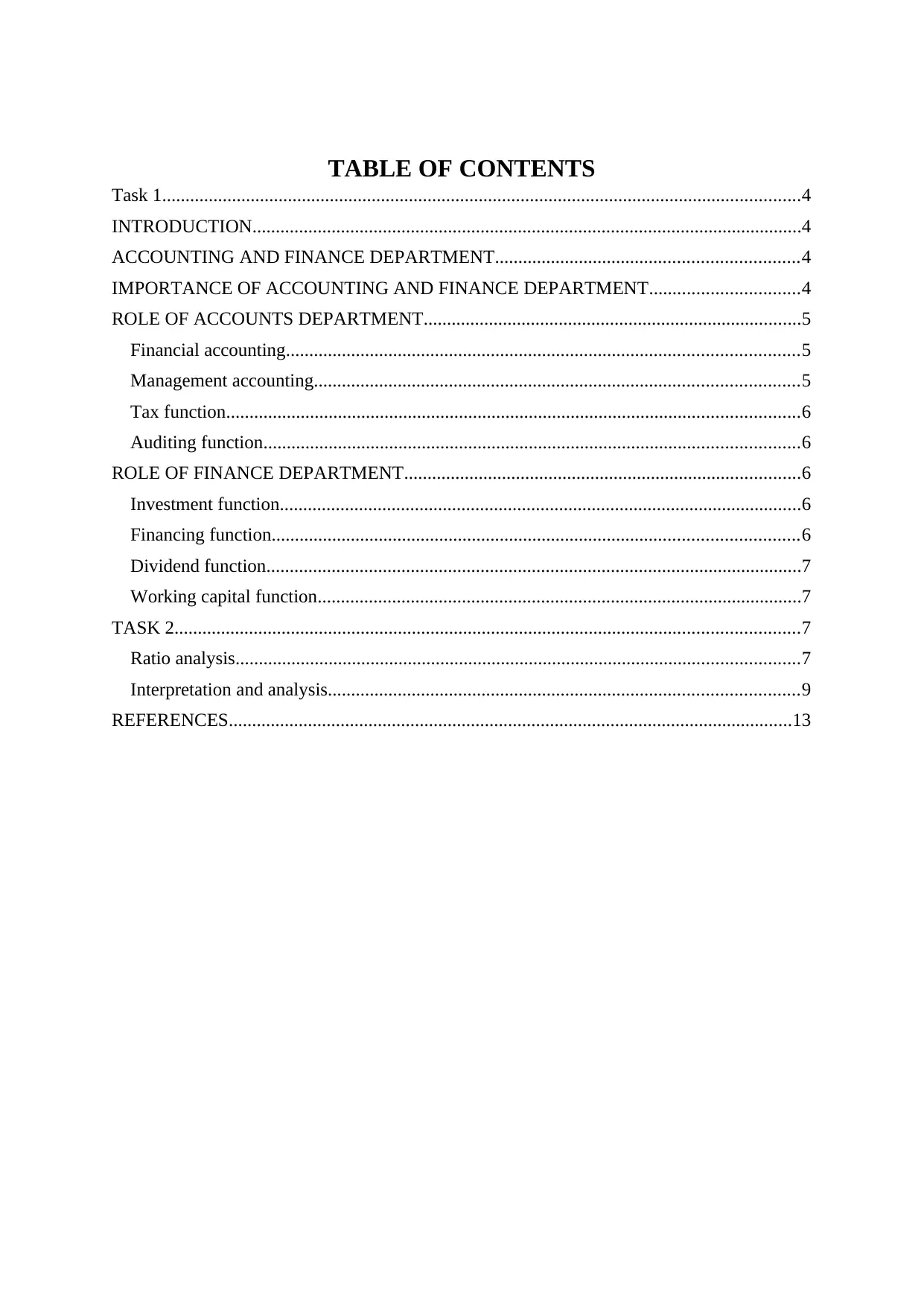
TABLE OF CONTENTS
Task 1.........................................................................................................................................4
INTRODUCTION......................................................................................................................4
ACCOUNTING AND FINANCE DEPARTMENT.................................................................4
IMPORTANCE OF ACCOUNTING AND FINANCE DEPARTMENT................................4
ROLE OF ACCOUNTS DEPARTMENT.................................................................................5
Financial accounting..............................................................................................................5
Management accounting........................................................................................................5
Tax function...........................................................................................................................6
Auditing function...................................................................................................................6
ROLE OF FINANCE DEPARTMENT.....................................................................................6
Investment function................................................................................................................6
Financing function.................................................................................................................6
Dividend function...................................................................................................................7
Working capital function........................................................................................................7
TASK 2......................................................................................................................................7
Ratio analysis.........................................................................................................................7
Interpretation and analysis.....................................................................................................9
REFERENCES.........................................................................................................................13
Task 1.........................................................................................................................................4
INTRODUCTION......................................................................................................................4
ACCOUNTING AND FINANCE DEPARTMENT.................................................................4
IMPORTANCE OF ACCOUNTING AND FINANCE DEPARTMENT................................4
ROLE OF ACCOUNTS DEPARTMENT.................................................................................5
Financial accounting..............................................................................................................5
Management accounting........................................................................................................5
Tax function...........................................................................................................................6
Auditing function...................................................................................................................6
ROLE OF FINANCE DEPARTMENT.....................................................................................6
Investment function................................................................................................................6
Financing function.................................................................................................................6
Dividend function...................................................................................................................7
Working capital function........................................................................................................7
TASK 2......................................................................................................................................7
Ratio analysis.........................................................................................................................7
Interpretation and analysis.....................................................................................................9
REFERENCES.........................................................................................................................13

Task 1
INTRODUCTION
Financial decision making is the process of taking relevant steps and decision with
respect to the financial resources of the organization. These decisions are very crucial for
effectively managing the business. In this report, Morrisons is taken as an organization,
which is the leading supermarket chain in UK. It is headquartered in Bradford, England. It
was founded in 1899 by William Morrison. It has over 500 stores in UK and its business is
mostly into food and grocery. This report states about the role importance of accounting and
finance department with respect to the organization.
ACCOUNTING AND FINANCE DEPARTMENT
Accounting department
It is the part of company’s administration which is responsible for setting up the
financial reports by keeping up with the general ledger, paying bills, payroll, cost accounting
and financial analysis and more. The head of the accounting department also has the title of
controller (accounting department definition. 2020). The staff members of the company deal
with the accounting. In small companies, one or two people handles the all accounting affairs.
In large organizations, there are multiple sub-departments for handling different task such as
taxation, account receivables and so forth.
Finance department
Finance department is that part of the organization that manages money of the
organization (finance department. 2020). The business function of the finance department
mainly incorporates planning, organizing, accounting, auditing and the controlling and
managing the company’s financial statements. The finance department assesses the
organizational health which helps in taking decisions regarding short term and long-term
plans.
IMPORTANCE OF ACCOUNTING AND FINANCE DEPARTMENT
Accounting and finance department is very important for an organization for
navigating the business. They play an essential role in effectively managing the business. All
the companies operate on money because of which it is very important to handle it carefully.
The accounting and finance department of Morrisons, maintains the complete record of the
INTRODUCTION
Financial decision making is the process of taking relevant steps and decision with
respect to the financial resources of the organization. These decisions are very crucial for
effectively managing the business. In this report, Morrisons is taken as an organization,
which is the leading supermarket chain in UK. It is headquartered in Bradford, England. It
was founded in 1899 by William Morrison. It has over 500 stores in UK and its business is
mostly into food and grocery. This report states about the role importance of accounting and
finance department with respect to the organization.
ACCOUNTING AND FINANCE DEPARTMENT
Accounting department
It is the part of company’s administration which is responsible for setting up the
financial reports by keeping up with the general ledger, paying bills, payroll, cost accounting
and financial analysis and more. The head of the accounting department also has the title of
controller (accounting department definition. 2020). The staff members of the company deal
with the accounting. In small companies, one or two people handles the all accounting affairs.
In large organizations, there are multiple sub-departments for handling different task such as
taxation, account receivables and so forth.
Finance department
Finance department is that part of the organization that manages money of the
organization (finance department. 2020). The business function of the finance department
mainly incorporates planning, organizing, accounting, auditing and the controlling and
managing the company’s financial statements. The finance department assesses the
organizational health which helps in taking decisions regarding short term and long-term
plans.
IMPORTANCE OF ACCOUNTING AND FINANCE DEPARTMENT
Accounting and finance department is very important for an organization for
navigating the business. They play an essential role in effectively managing the business. All
the companies operate on money because of which it is very important to handle it carefully.
The accounting and finance department of Morrisons, maintains the complete record of the
Paraphrase This Document
Need a fresh take? Get an instant paraphrase of this document with our AI Paraphraser
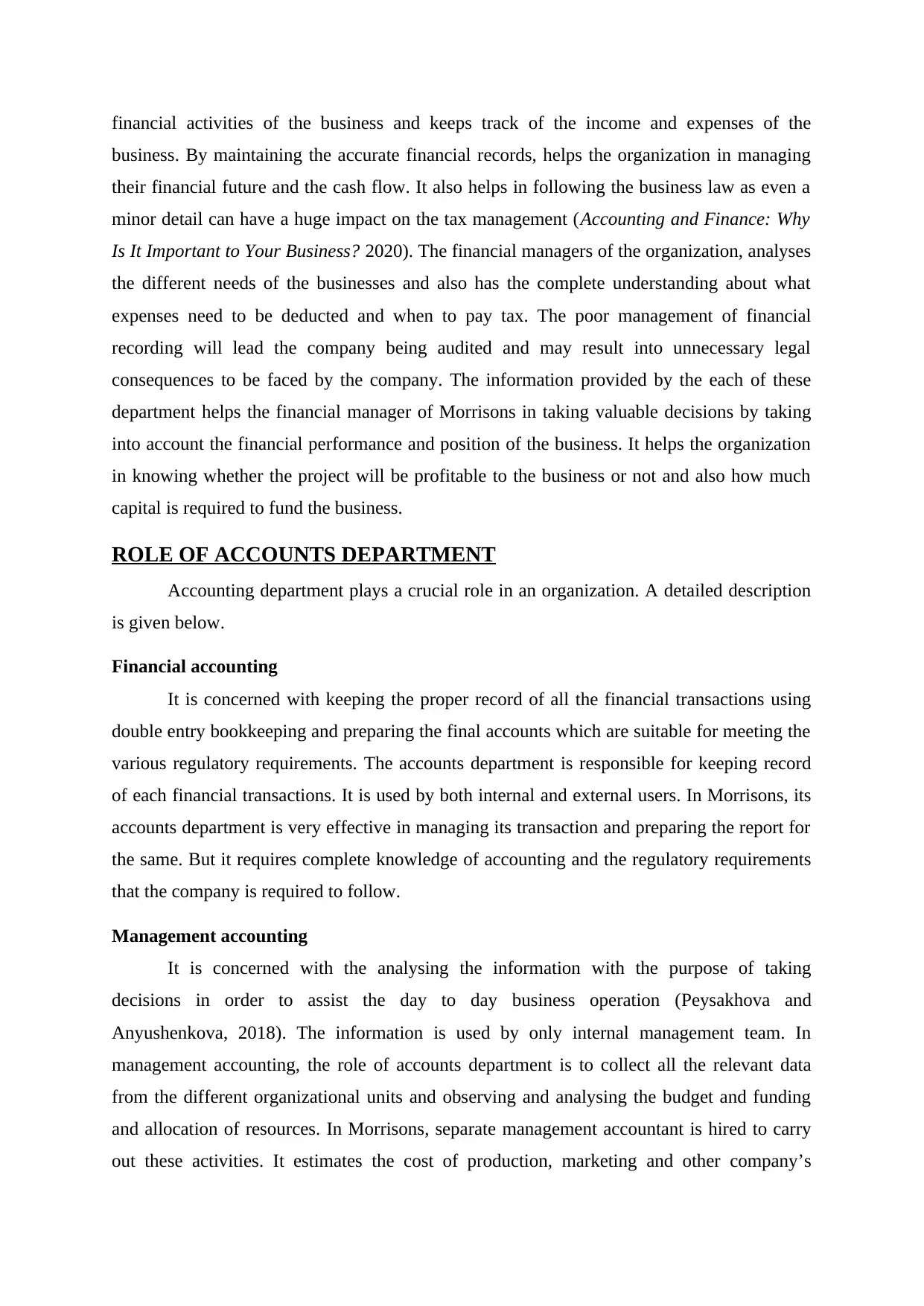
financial activities of the business and keeps track of the income and expenses of the
business. By maintaining the accurate financial records, helps the organization in managing
their financial future and the cash flow. It also helps in following the business law as even a
minor detail can have a huge impact on the tax management (Accounting and Finance: Why
Is It Important to Your Business? 2020). The financial managers of the organization, analyses
the different needs of the businesses and also has the complete understanding about what
expenses need to be deducted and when to pay tax. The poor management of financial
recording will lead the company being audited and may result into unnecessary legal
consequences to be faced by the company. The information provided by the each of these
department helps the financial manager of Morrisons in taking valuable decisions by taking
into account the financial performance and position of the business. It helps the organization
in knowing whether the project will be profitable to the business or not and also how much
capital is required to fund the business.
ROLE OF ACCOUNTS DEPARTMENT
Accounting department plays a crucial role in an organization. A detailed description
is given below.
Financial accounting
It is concerned with keeping the proper record of all the financial transactions using
double entry bookkeeping and preparing the final accounts which are suitable for meeting the
various regulatory requirements. The accounts department is responsible for keeping record
of each financial transactions. It is used by both internal and external users. In Morrisons, its
accounts department is very effective in managing its transaction and preparing the report for
the same. But it requires complete knowledge of accounting and the regulatory requirements
that the company is required to follow.
Management accounting
It is concerned with the analysing the information with the purpose of taking
decisions in order to assist the day to day business operation (Peysakhova and
Anyushenkova, 2018). The information is used by only internal management team. In
management accounting, the role of accounts department is to collect all the relevant data
from the different organizational units and observing and analysing the budget and funding
and allocation of resources. In Morrisons, separate management accountant is hired to carry
out these activities. It estimates the cost of production, marketing and other company’s
business. By maintaining the accurate financial records, helps the organization in managing
their financial future and the cash flow. It also helps in following the business law as even a
minor detail can have a huge impact on the tax management (Accounting and Finance: Why
Is It Important to Your Business? 2020). The financial managers of the organization, analyses
the different needs of the businesses and also has the complete understanding about what
expenses need to be deducted and when to pay tax. The poor management of financial
recording will lead the company being audited and may result into unnecessary legal
consequences to be faced by the company. The information provided by the each of these
department helps the financial manager of Morrisons in taking valuable decisions by taking
into account the financial performance and position of the business. It helps the organization
in knowing whether the project will be profitable to the business or not and also how much
capital is required to fund the business.
ROLE OF ACCOUNTS DEPARTMENT
Accounting department plays a crucial role in an organization. A detailed description
is given below.
Financial accounting
It is concerned with keeping the proper record of all the financial transactions using
double entry bookkeeping and preparing the final accounts which are suitable for meeting the
various regulatory requirements. The accounts department is responsible for keeping record
of each financial transactions. It is used by both internal and external users. In Morrisons, its
accounts department is very effective in managing its transaction and preparing the report for
the same. But it requires complete knowledge of accounting and the regulatory requirements
that the company is required to follow.
Management accounting
It is concerned with the analysing the information with the purpose of taking
decisions in order to assist the day to day business operation (Peysakhova and
Anyushenkova, 2018). The information is used by only internal management team. In
management accounting, the role of accounts department is to collect all the relevant data
from the different organizational units and observing and analysing the budget and funding
and allocation of resources. In Morrisons, separate management accountant is hired to carry
out these activities. It estimates the cost of production, marketing and other company’s
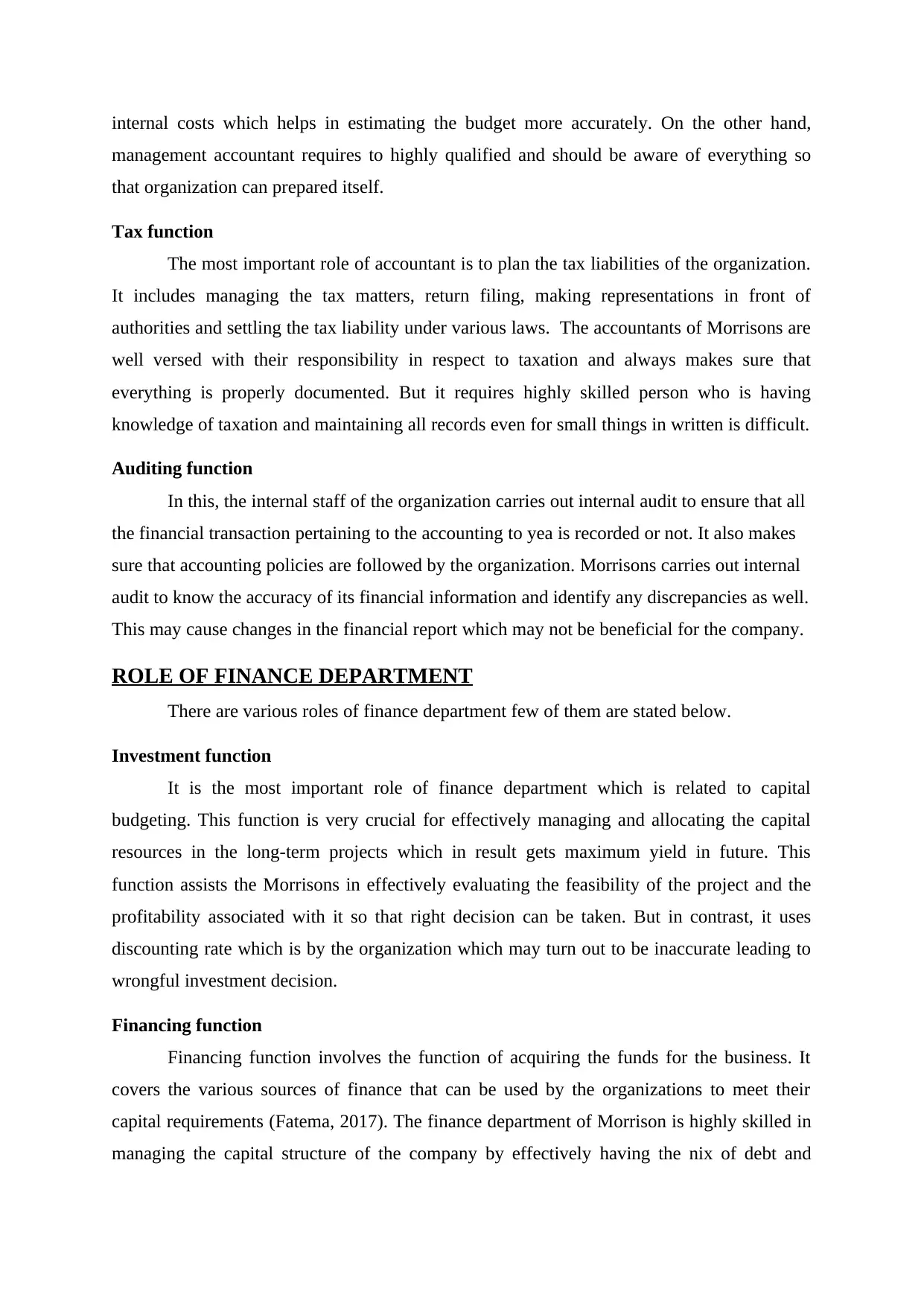
internal costs which helps in estimating the budget more accurately. On the other hand,
management accountant requires to highly qualified and should be aware of everything so
that organization can prepared itself.
Tax function
The most important role of accountant is to plan the tax liabilities of the organization.
It includes managing the tax matters, return filing, making representations in front of
authorities and settling the tax liability under various laws. The accountants of Morrisons are
well versed with their responsibility in respect to taxation and always makes sure that
everything is properly documented. But it requires highly skilled person who is having
knowledge of taxation and maintaining all records even for small things in written is difficult.
Auditing function
In this, the internal staff of the organization carries out internal audit to ensure that all
the financial transaction pertaining to the accounting to yea is recorded or not. It also makes
sure that accounting policies are followed by the organization. Morrisons carries out internal
audit to know the accuracy of its financial information and identify any discrepancies as well.
This may cause changes in the financial report which may not be beneficial for the company.
ROLE OF FINANCE DEPARTMENT
There are various roles of finance department few of them are stated below.
Investment function
It is the most important role of finance department which is related to capital
budgeting. This function is very crucial for effectively managing and allocating the capital
resources in the long-term projects which in result gets maximum yield in future. This
function assists the Morrisons in effectively evaluating the feasibility of the project and the
profitability associated with it so that right decision can be taken. But in contrast, it uses
discounting rate which is by the organization which may turn out to be inaccurate leading to
wrongful investment decision.
Financing function
Financing function involves the function of acquiring the funds for the business. It
covers the various sources of finance that can be used by the organizations to meet their
capital requirements (Fatema, 2017). The finance department of Morrison is highly skilled in
managing the capital structure of the company by effectively having the nix of debt and
management accountant requires to highly qualified and should be aware of everything so
that organization can prepared itself.
Tax function
The most important role of accountant is to plan the tax liabilities of the organization.
It includes managing the tax matters, return filing, making representations in front of
authorities and settling the tax liability under various laws. The accountants of Morrisons are
well versed with their responsibility in respect to taxation and always makes sure that
everything is properly documented. But it requires highly skilled person who is having
knowledge of taxation and maintaining all records even for small things in written is difficult.
Auditing function
In this, the internal staff of the organization carries out internal audit to ensure that all
the financial transaction pertaining to the accounting to yea is recorded or not. It also makes
sure that accounting policies are followed by the organization. Morrisons carries out internal
audit to know the accuracy of its financial information and identify any discrepancies as well.
This may cause changes in the financial report which may not be beneficial for the company.
ROLE OF FINANCE DEPARTMENT
There are various roles of finance department few of them are stated below.
Investment function
It is the most important role of finance department which is related to capital
budgeting. This function is very crucial for effectively managing and allocating the capital
resources in the long-term projects which in result gets maximum yield in future. This
function assists the Morrisons in effectively evaluating the feasibility of the project and the
profitability associated with it so that right decision can be taken. But in contrast, it uses
discounting rate which is by the organization which may turn out to be inaccurate leading to
wrongful investment decision.
Financing function
Financing function involves the function of acquiring the funds for the business. It
covers the various sources of finance that can be used by the organizations to meet their
capital requirements (Fatema, 2017). The finance department of Morrison is highly skilled in
managing the capital structure of the company by effectively having the nix of debt and
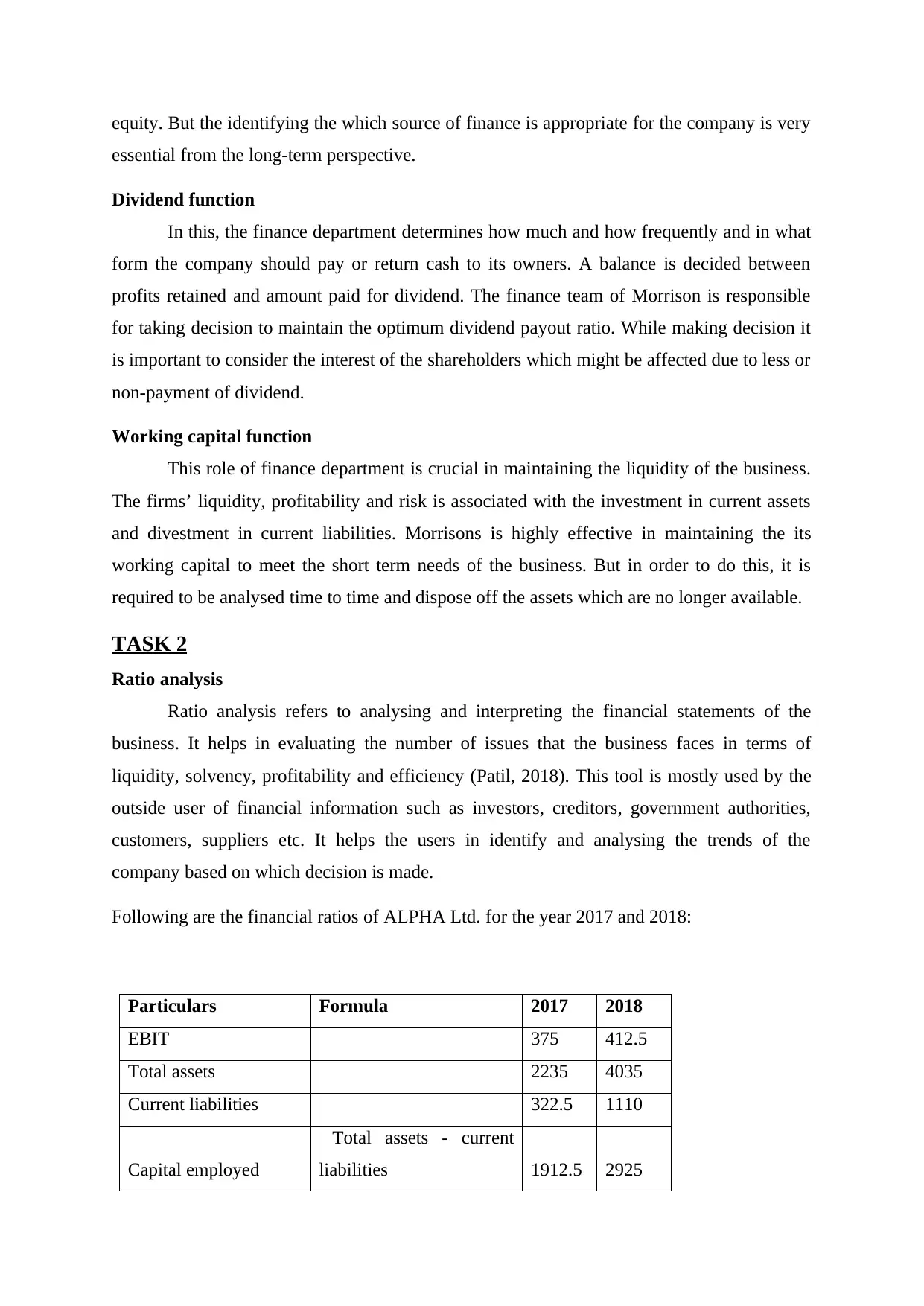
equity. But the identifying the which source of finance is appropriate for the company is very
essential from the long-term perspective.
Dividend function
In this, the finance department determines how much and how frequently and in what
form the company should pay or return cash to its owners. A balance is decided between
profits retained and amount paid for dividend. The finance team of Morrison is responsible
for taking decision to maintain the optimum dividend payout ratio. While making decision it
is important to consider the interest of the shareholders which might be affected due to less or
non-payment of dividend.
Working capital function
This role of finance department is crucial in maintaining the liquidity of the business.
The firms’ liquidity, profitability and risk is associated with the investment in current assets
and divestment in current liabilities. Morrisons is highly effective in maintaining the its
working capital to meet the short term needs of the business. But in order to do this, it is
required to be analysed time to time and dispose off the assets which are no longer available.
TASK 2
Ratio analysis
Ratio analysis refers to analysing and interpreting the financial statements of the
business. It helps in evaluating the number of issues that the business faces in terms of
liquidity, solvency, profitability and efficiency (Patil, 2018). This tool is mostly used by the
outside user of financial information such as investors, creditors, government authorities,
customers, suppliers etc. It helps the users in identify and analysing the trends of the
company based on which decision is made.
Following are the financial ratios of ALPHA Ltd. for the year 2017 and 2018:
Particulars Formula 2017 2018
EBIT 375 412.5
Total assets 2235 4035
Current liabilities 322.5 1110
Capital employed
Total assets - current
liabilities 1912.5 2925
essential from the long-term perspective.
Dividend function
In this, the finance department determines how much and how frequently and in what
form the company should pay or return cash to its owners. A balance is decided between
profits retained and amount paid for dividend. The finance team of Morrison is responsible
for taking decision to maintain the optimum dividend payout ratio. While making decision it
is important to consider the interest of the shareholders which might be affected due to less or
non-payment of dividend.
Working capital function
This role of finance department is crucial in maintaining the liquidity of the business.
The firms’ liquidity, profitability and risk is associated with the investment in current assets
and divestment in current liabilities. Morrisons is highly effective in maintaining the its
working capital to meet the short term needs of the business. But in order to do this, it is
required to be analysed time to time and dispose off the assets which are no longer available.
TASK 2
Ratio analysis
Ratio analysis refers to analysing and interpreting the financial statements of the
business. It helps in evaluating the number of issues that the business faces in terms of
liquidity, solvency, profitability and efficiency (Patil, 2018). This tool is mostly used by the
outside user of financial information such as investors, creditors, government authorities,
customers, suppliers etc. It helps the users in identify and analysing the trends of the
company based on which decision is made.
Following are the financial ratios of ALPHA Ltd. for the year 2017 and 2018:
Particulars Formula 2017 2018
EBIT 375 412.5
Total assets 2235 4035
Current liabilities 322.5 1110
Capital employed
Total assets - current
liabilities 1912.5 2925
Secure Best Marks with AI Grader
Need help grading? Try our AI Grader for instant feedback on your assignments.
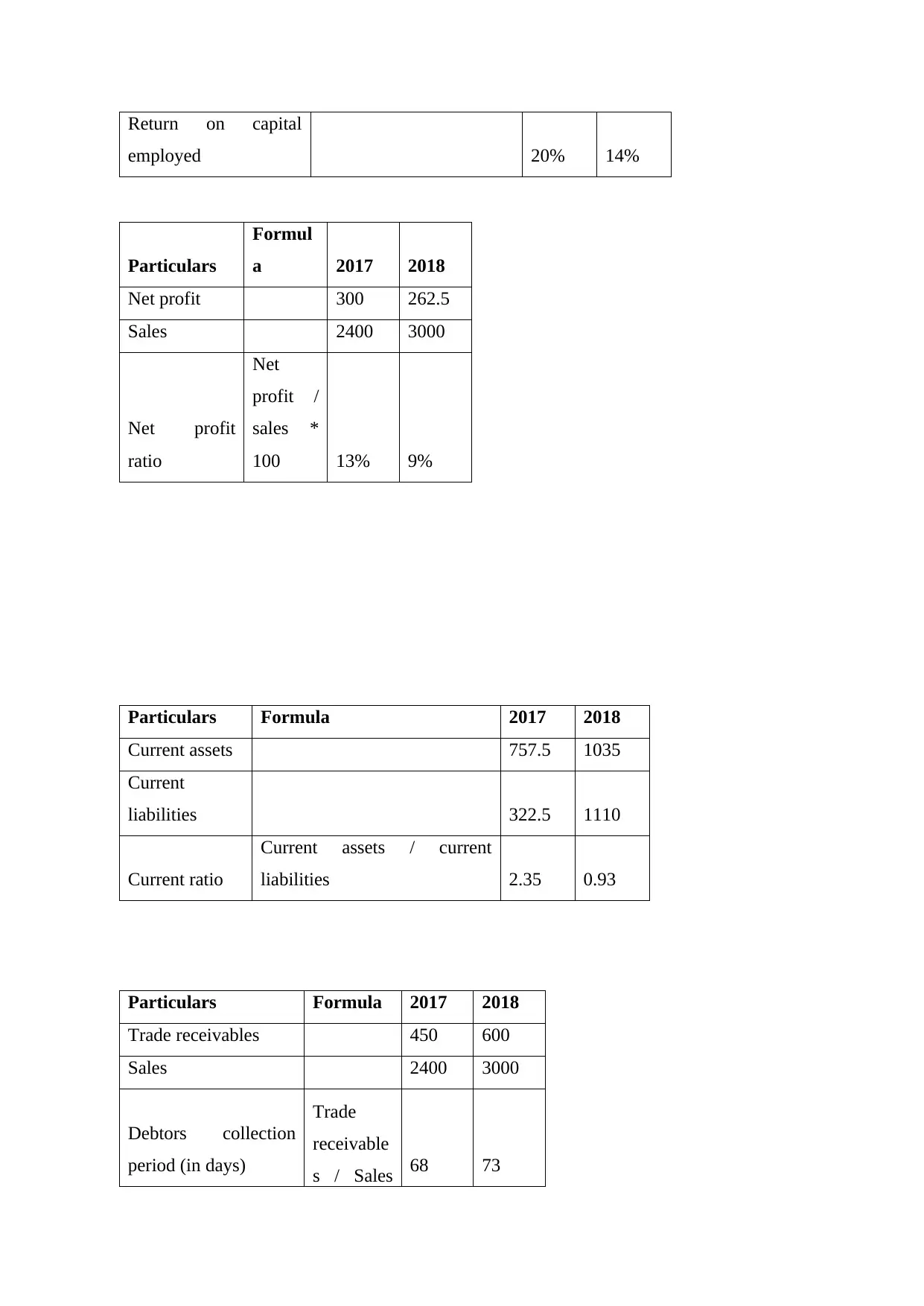
Return on capital
employed 20% 14%
Particulars
Formul
a 2017 2018
Net profit 300 262.5
Sales 2400 3000
Net profit
ratio
Net
profit /
sales *
100 13% 9%
Particulars Formula 2017 2018
Current assets 757.5 1035
Current
liabilities 322.5 1110
Current ratio
Current assets / current
liabilities 2.35 0.93
Particulars Formula 2017 2018
Trade receivables 450 600
Sales 2400 3000
Debtors collection
period (in days)
Trade
receivable
s / Sales 68 73
employed 20% 14%
Particulars
Formul
a 2017 2018
Net profit 300 262.5
Sales 2400 3000
Net profit
ratio
Net
profit /
sales *
100 13% 9%
Particulars Formula 2017 2018
Current assets 757.5 1035
Current
liabilities 322.5 1110
Current ratio
Current assets / current
liabilities 2.35 0.93
Particulars Formula 2017 2018
Trade receivables 450 600
Sales 2400 3000
Debtors collection
period (in days)
Trade
receivable
s / Sales 68 73

*365
Particulars Formula 2017 2018
Trade payables 285 1050
Purchase 1725 2250
Creditors payment
period
Trade
payables
/
purchase
*365 60 170
Interpretation and analysis
Return on capital employed (ROCE)
The return on capital employed is the financial ratio used to measure the profitability
of the company. It analyses how effectively company is utilizing its capital employed. It can
be evaluated by looking at the profitability of the company. In simple words, it indicates
investors how much money is being generated for every pound invested (Murtala and et.al,
2018). It is one of the most significant financial ratios considered by the decision makers for
taking decision whether to put resources into the organization or not. It assesses how
adequately organization is using it resources alongside considering the long-term financing.
The organizations and investors anticipate the higher pace of return in contrast with the rate
of borrowings. It is utilized for different decision making processes by the managers. The
higher ratio depicts that the organization is creating more profits (Johan, 2018). It is
determined by dividing EBIT to the total capital employed. The return on capital employed of
ALPHA Ltd. has decreased from 20% in 2017 to 14% in 2018. This means that the company
is not effective in managing and utilizing its capital employed and also it is not able to
generate higher shareholder value. Investors are interested in investing in only those
companies which has an increasing return on capital employed. The lower ratio may be
Particulars Formula 2017 2018
Trade payables 285 1050
Purchase 1725 2250
Creditors payment
period
Trade
payables
/
purchase
*365 60 170
Interpretation and analysis
Return on capital employed (ROCE)
The return on capital employed is the financial ratio used to measure the profitability
of the company. It analyses how effectively company is utilizing its capital employed. It can
be evaluated by looking at the profitability of the company. In simple words, it indicates
investors how much money is being generated for every pound invested (Murtala and et.al,
2018). It is one of the most significant financial ratios considered by the decision makers for
taking decision whether to put resources into the organization or not. It assesses how
adequately organization is using it resources alongside considering the long-term financing.
The organizations and investors anticipate the higher pace of return in contrast with the rate
of borrowings. It is utilized for different decision making processes by the managers. The
higher ratio depicts that the organization is creating more profits (Johan, 2018). It is
determined by dividing EBIT to the total capital employed. The return on capital employed of
ALPHA Ltd. has decreased from 20% in 2017 to 14% in 2018. This means that the company
is not effective in managing and utilizing its capital employed and also it is not able to
generate higher shareholder value. Investors are interested in investing in only those
companies which has an increasing return on capital employed. The lower ratio may be
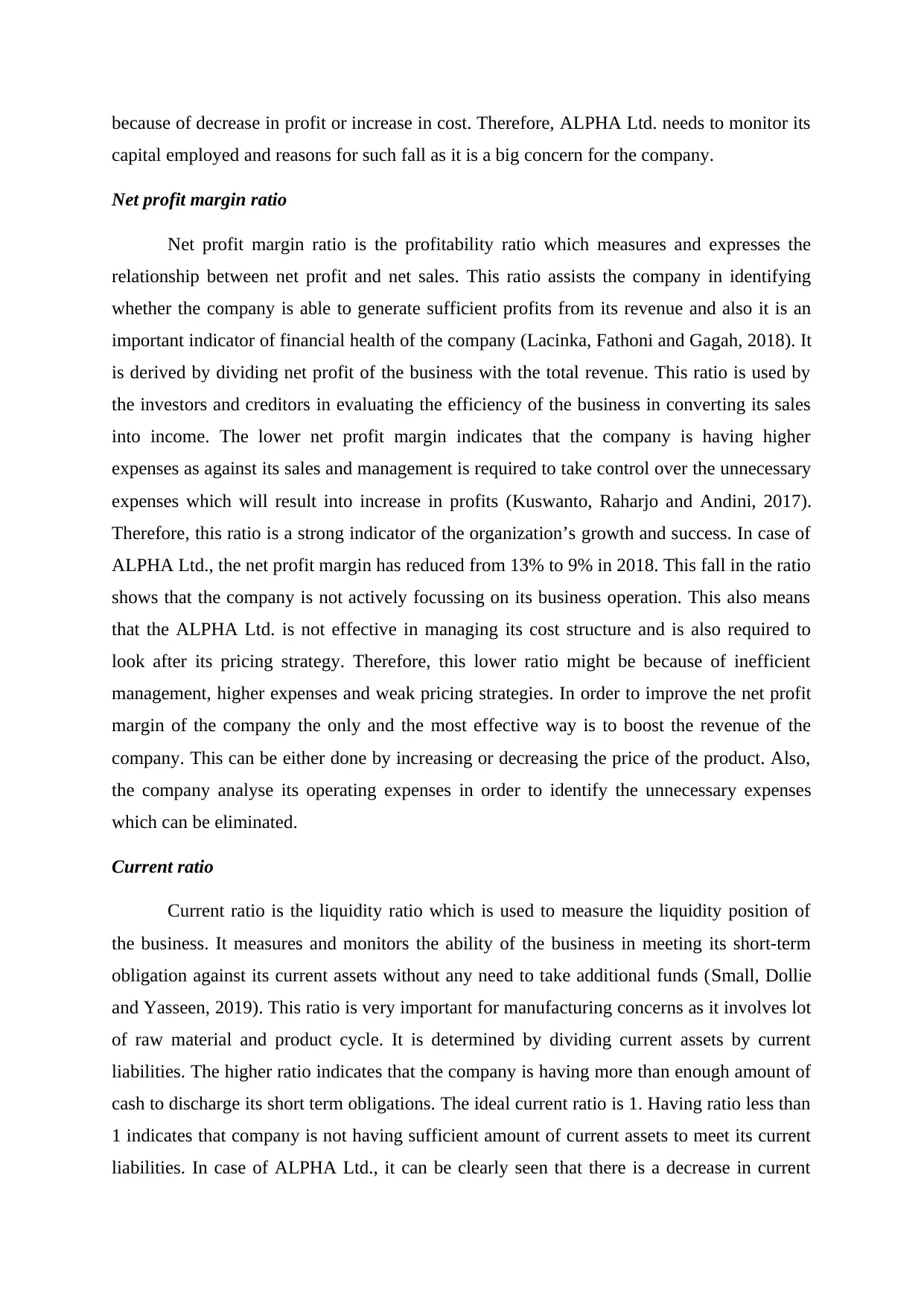
because of decrease in profit or increase in cost. Therefore, ALPHA Ltd. needs to monitor its
capital employed and reasons for such fall as it is a big concern for the company.
Net profit margin ratio
Net profit margin ratio is the profitability ratio which measures and expresses the
relationship between net profit and net sales. This ratio assists the company in identifying
whether the company is able to generate sufficient profits from its revenue and also it is an
important indicator of financial health of the company (Lacinka, Fathoni and Gagah, 2018). It
is derived by dividing net profit of the business with the total revenue. This ratio is used by
the investors and creditors in evaluating the efficiency of the business in converting its sales
into income. The lower net profit margin indicates that the company is having higher
expenses as against its sales and management is required to take control over the unnecessary
expenses which will result into increase in profits (Kuswanto, Raharjo and Andini, 2017).
Therefore, this ratio is a strong indicator of the organization’s growth and success. In case of
ALPHA Ltd., the net profit margin has reduced from 13% to 9% in 2018. This fall in the ratio
shows that the company is not actively focussing on its business operation. This also means
that the ALPHA Ltd. is not effective in managing its cost structure and is also required to
look after its pricing strategy. Therefore, this lower ratio might be because of inefficient
management, higher expenses and weak pricing strategies. In order to improve the net profit
margin of the company the only and the most effective way is to boost the revenue of the
company. This can be either done by increasing or decreasing the price of the product. Also,
the company analyse its operating expenses in order to identify the unnecessary expenses
which can be eliminated.
Current ratio
Current ratio is the liquidity ratio which is used to measure the liquidity position of
the business. It measures and monitors the ability of the business in meeting its short-term
obligation against its current assets without any need to take additional funds (Small, Dollie
and Yasseen, 2019). This ratio is very important for manufacturing concerns as it involves lot
of raw material and product cycle. It is determined by dividing current assets by current
liabilities. The higher ratio indicates that the company is having more than enough amount of
cash to discharge its short term obligations. The ideal current ratio is 1. Having ratio less than
1 indicates that company is not having sufficient amount of current assets to meet its current
liabilities. In case of ALPHA Ltd., it can be clearly seen that there is a decrease in current
capital employed and reasons for such fall as it is a big concern for the company.
Net profit margin ratio
Net profit margin ratio is the profitability ratio which measures and expresses the
relationship between net profit and net sales. This ratio assists the company in identifying
whether the company is able to generate sufficient profits from its revenue and also it is an
important indicator of financial health of the company (Lacinka, Fathoni and Gagah, 2018). It
is derived by dividing net profit of the business with the total revenue. This ratio is used by
the investors and creditors in evaluating the efficiency of the business in converting its sales
into income. The lower net profit margin indicates that the company is having higher
expenses as against its sales and management is required to take control over the unnecessary
expenses which will result into increase in profits (Kuswanto, Raharjo and Andini, 2017).
Therefore, this ratio is a strong indicator of the organization’s growth and success. In case of
ALPHA Ltd., the net profit margin has reduced from 13% to 9% in 2018. This fall in the ratio
shows that the company is not actively focussing on its business operation. This also means
that the ALPHA Ltd. is not effective in managing its cost structure and is also required to
look after its pricing strategy. Therefore, this lower ratio might be because of inefficient
management, higher expenses and weak pricing strategies. In order to improve the net profit
margin of the company the only and the most effective way is to boost the revenue of the
company. This can be either done by increasing or decreasing the price of the product. Also,
the company analyse its operating expenses in order to identify the unnecessary expenses
which can be eliminated.
Current ratio
Current ratio is the liquidity ratio which is used to measure the liquidity position of
the business. It measures and monitors the ability of the business in meeting its short-term
obligation against its current assets without any need to take additional funds (Small, Dollie
and Yasseen, 2019). This ratio is very important for manufacturing concerns as it involves lot
of raw material and product cycle. It is determined by dividing current assets by current
liabilities. The higher ratio indicates that the company is having more than enough amount of
cash to discharge its short term obligations. The ideal current ratio is 1. Having ratio less than
1 indicates that company is not having sufficient amount of current assets to meet its current
liabilities. In case of ALPHA Ltd., it can be clearly seen that there is a decrease in current
Paraphrase This Document
Need a fresh take? Get an instant paraphrase of this document with our AI Paraphraser
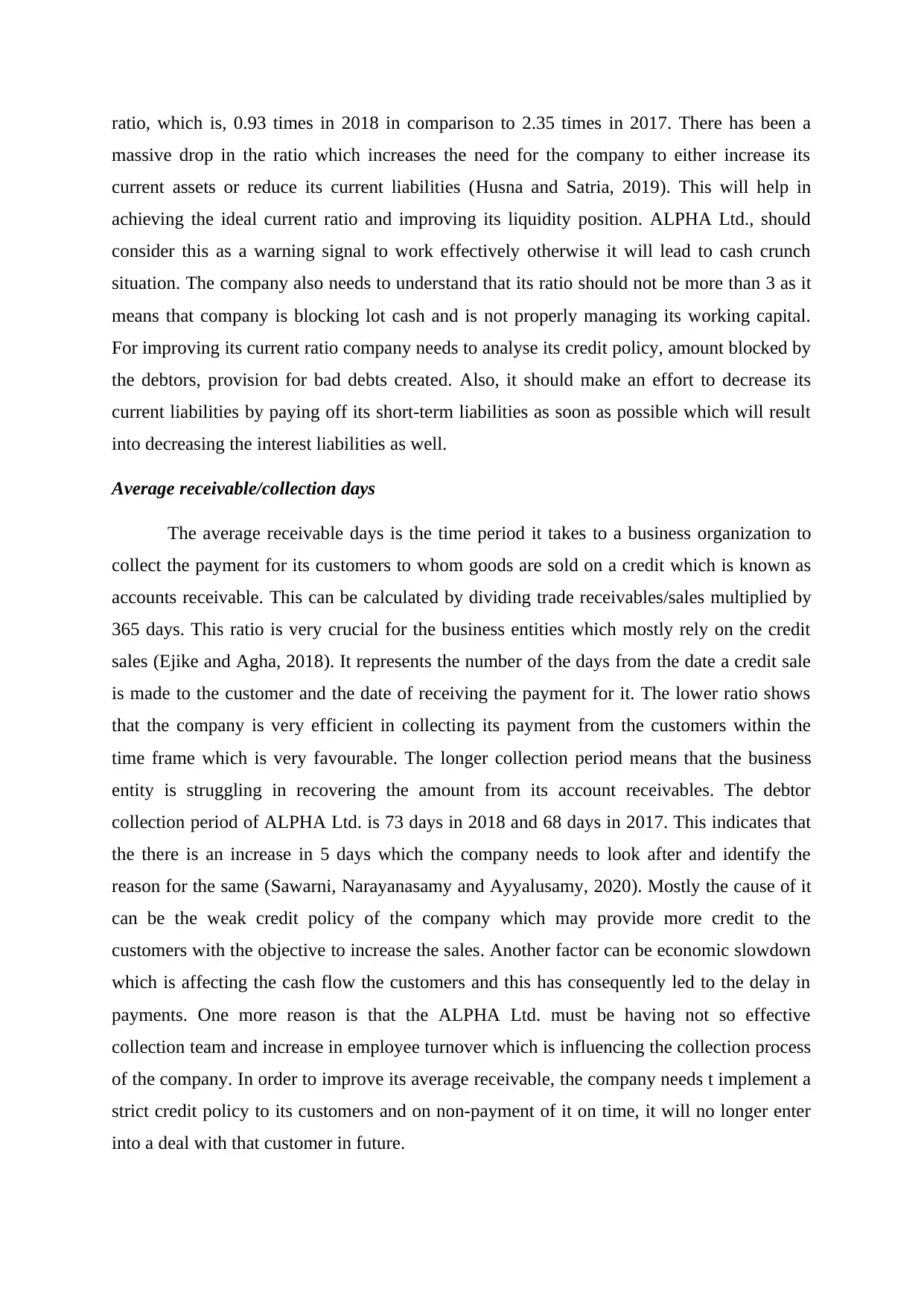
ratio, which is, 0.93 times in 2018 in comparison to 2.35 times in 2017. There has been a
massive drop in the ratio which increases the need for the company to either increase its
current assets or reduce its current liabilities (Husna and Satria, 2019). This will help in
achieving the ideal current ratio and improving its liquidity position. ALPHA Ltd., should
consider this as a warning signal to work effectively otherwise it will lead to cash crunch
situation. The company also needs to understand that its ratio should not be more than 3 as it
means that company is blocking lot cash and is not properly managing its working capital.
For improving its current ratio company needs to analyse its credit policy, amount blocked by
the debtors, provision for bad debts created. Also, it should make an effort to decrease its
current liabilities by paying off its short-term liabilities as soon as possible which will result
into decreasing the interest liabilities as well.
Average receivable/collection days
The average receivable days is the time period it takes to a business organization to
collect the payment for its customers to whom goods are sold on a credit which is known as
accounts receivable. This can be calculated by dividing trade receivables/sales multiplied by
365 days. This ratio is very crucial for the business entities which mostly rely on the credit
sales (Ejike and Agha, 2018). It represents the number of the days from the date a credit sale
is made to the customer and the date of receiving the payment for it. The lower ratio shows
that the company is very efficient in collecting its payment from the customers within the
time frame which is very favourable. The longer collection period means that the business
entity is struggling in recovering the amount from its account receivables. The debtor
collection period of ALPHA Ltd. is 73 days in 2018 and 68 days in 2017. This indicates that
the there is an increase in 5 days which the company needs to look after and identify the
reason for the same (Sawarni, Narayanasamy and Ayyalusamy, 2020). Mostly the cause of it
can be the weak credit policy of the company which may provide more credit to the
customers with the objective to increase the sales. Another factor can be economic slowdown
which is affecting the cash flow the customers and this has consequently led to the delay in
payments. One more reason is that the ALPHA Ltd. must be having not so effective
collection team and increase in employee turnover which is influencing the collection process
of the company. In order to improve its average receivable, the company needs t implement a
strict credit policy to its customers and on non-payment of it on time, it will no longer enter
into a deal with that customer in future.
massive drop in the ratio which increases the need for the company to either increase its
current assets or reduce its current liabilities (Husna and Satria, 2019). This will help in
achieving the ideal current ratio and improving its liquidity position. ALPHA Ltd., should
consider this as a warning signal to work effectively otherwise it will lead to cash crunch
situation. The company also needs to understand that its ratio should not be more than 3 as it
means that company is blocking lot cash and is not properly managing its working capital.
For improving its current ratio company needs to analyse its credit policy, amount blocked by
the debtors, provision for bad debts created. Also, it should make an effort to decrease its
current liabilities by paying off its short-term liabilities as soon as possible which will result
into decreasing the interest liabilities as well.
Average receivable/collection days
The average receivable days is the time period it takes to a business organization to
collect the payment for its customers to whom goods are sold on a credit which is known as
accounts receivable. This can be calculated by dividing trade receivables/sales multiplied by
365 days. This ratio is very crucial for the business entities which mostly rely on the credit
sales (Ejike and Agha, 2018). It represents the number of the days from the date a credit sale
is made to the customer and the date of receiving the payment for it. The lower ratio shows
that the company is very efficient in collecting its payment from the customers within the
time frame which is very favourable. The longer collection period means that the business
entity is struggling in recovering the amount from its account receivables. The debtor
collection period of ALPHA Ltd. is 73 days in 2018 and 68 days in 2017. This indicates that
the there is an increase in 5 days which the company needs to look after and identify the
reason for the same (Sawarni, Narayanasamy and Ayyalusamy, 2020). Mostly the cause of it
can be the weak credit policy of the company which may provide more credit to the
customers with the objective to increase the sales. Another factor can be economic slowdown
which is affecting the cash flow the customers and this has consequently led to the delay in
payments. One more reason is that the ALPHA Ltd. must be having not so effective
collection team and increase in employee turnover which is influencing the collection process
of the company. In order to improve its average receivable, the company needs t implement a
strict credit policy to its customers and on non-payment of it on time, it will no longer enter
into a deal with that customer in future.
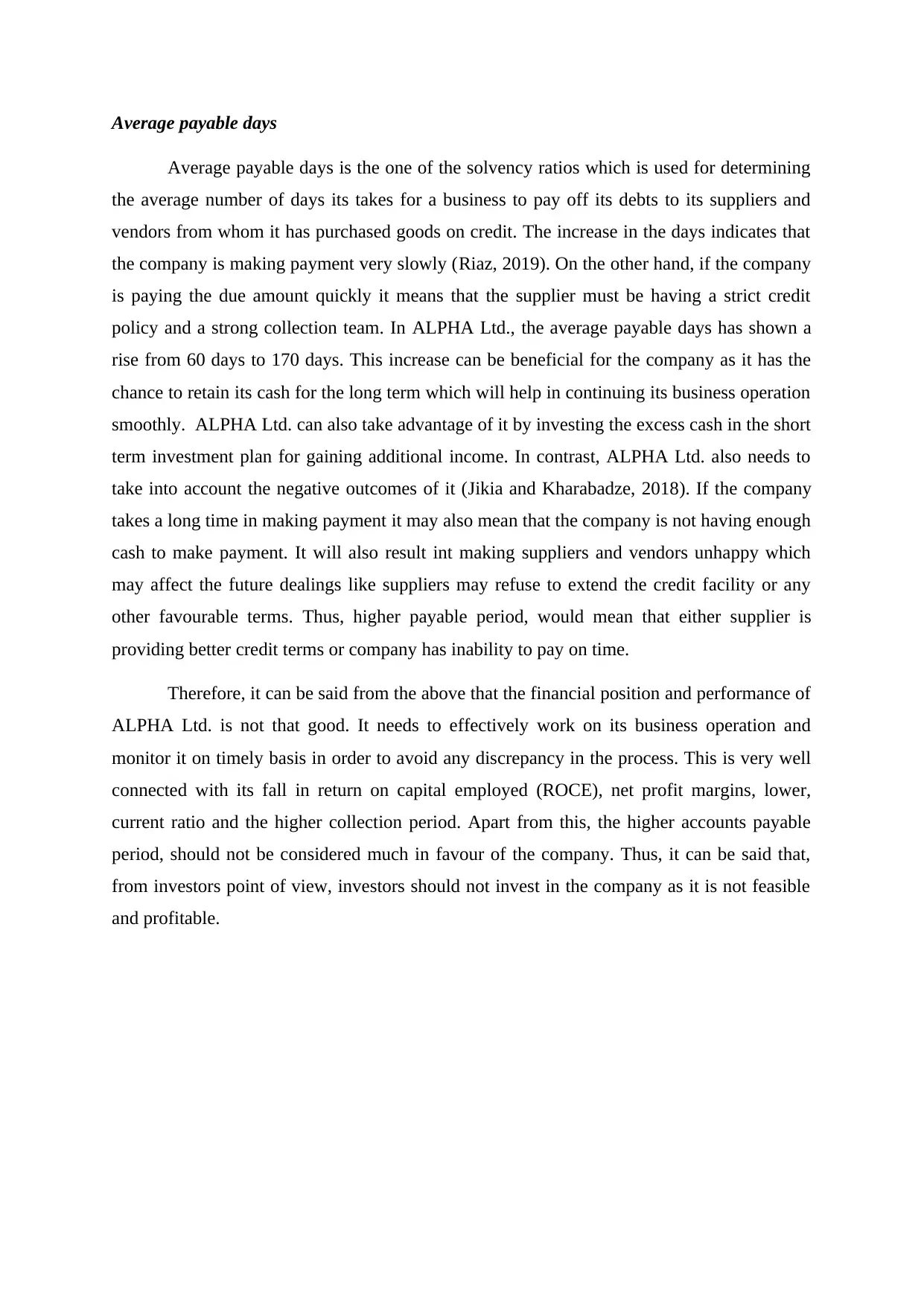
Average payable days
Average payable days is the one of the solvency ratios which is used for determining
the average number of days its takes for a business to pay off its debts to its suppliers and
vendors from whom it has purchased goods on credit. The increase in the days indicates that
the company is making payment very slowly (Riaz, 2019). On the other hand, if the company
is paying the due amount quickly it means that the supplier must be having a strict credit
policy and a strong collection team. In ALPHA Ltd., the average payable days has shown a
rise from 60 days to 170 days. This increase can be beneficial for the company as it has the
chance to retain its cash for the long term which will help in continuing its business operation
smoothly. ALPHA Ltd. can also take advantage of it by investing the excess cash in the short
term investment plan for gaining additional income. In contrast, ALPHA Ltd. also needs to
take into account the negative outcomes of it (Jikia and Kharabadze, 2018). If the company
takes a long time in making payment it may also mean that the company is not having enough
cash to make payment. It will also result int making suppliers and vendors unhappy which
may affect the future dealings like suppliers may refuse to extend the credit facility or any
other favourable terms. Thus, higher payable period, would mean that either supplier is
providing better credit terms or company has inability to pay on time.
Therefore, it can be said from the above that the financial position and performance of
ALPHA Ltd. is not that good. It needs to effectively work on its business operation and
monitor it on timely basis in order to avoid any discrepancy in the process. This is very well
connected with its fall in return on capital employed (ROCE), net profit margins, lower,
current ratio and the higher collection period. Apart from this, the higher accounts payable
period, should not be considered much in favour of the company. Thus, it can be said that,
from investors point of view, investors should not invest in the company as it is not feasible
and profitable.
Average payable days is the one of the solvency ratios which is used for determining
the average number of days its takes for a business to pay off its debts to its suppliers and
vendors from whom it has purchased goods on credit. The increase in the days indicates that
the company is making payment very slowly (Riaz, 2019). On the other hand, if the company
is paying the due amount quickly it means that the supplier must be having a strict credit
policy and a strong collection team. In ALPHA Ltd., the average payable days has shown a
rise from 60 days to 170 days. This increase can be beneficial for the company as it has the
chance to retain its cash for the long term which will help in continuing its business operation
smoothly. ALPHA Ltd. can also take advantage of it by investing the excess cash in the short
term investment plan for gaining additional income. In contrast, ALPHA Ltd. also needs to
take into account the negative outcomes of it (Jikia and Kharabadze, 2018). If the company
takes a long time in making payment it may also mean that the company is not having enough
cash to make payment. It will also result int making suppliers and vendors unhappy which
may affect the future dealings like suppliers may refuse to extend the credit facility or any
other favourable terms. Thus, higher payable period, would mean that either supplier is
providing better credit terms or company has inability to pay on time.
Therefore, it can be said from the above that the financial position and performance of
ALPHA Ltd. is not that good. It needs to effectively work on its business operation and
monitor it on timely basis in order to avoid any discrepancy in the process. This is very well
connected with its fall in return on capital employed (ROCE), net profit margins, lower,
current ratio and the higher collection period. Apart from this, the higher accounts payable
period, should not be considered much in favour of the company. Thus, it can be said that,
from investors point of view, investors should not invest in the company as it is not feasible
and profitable.
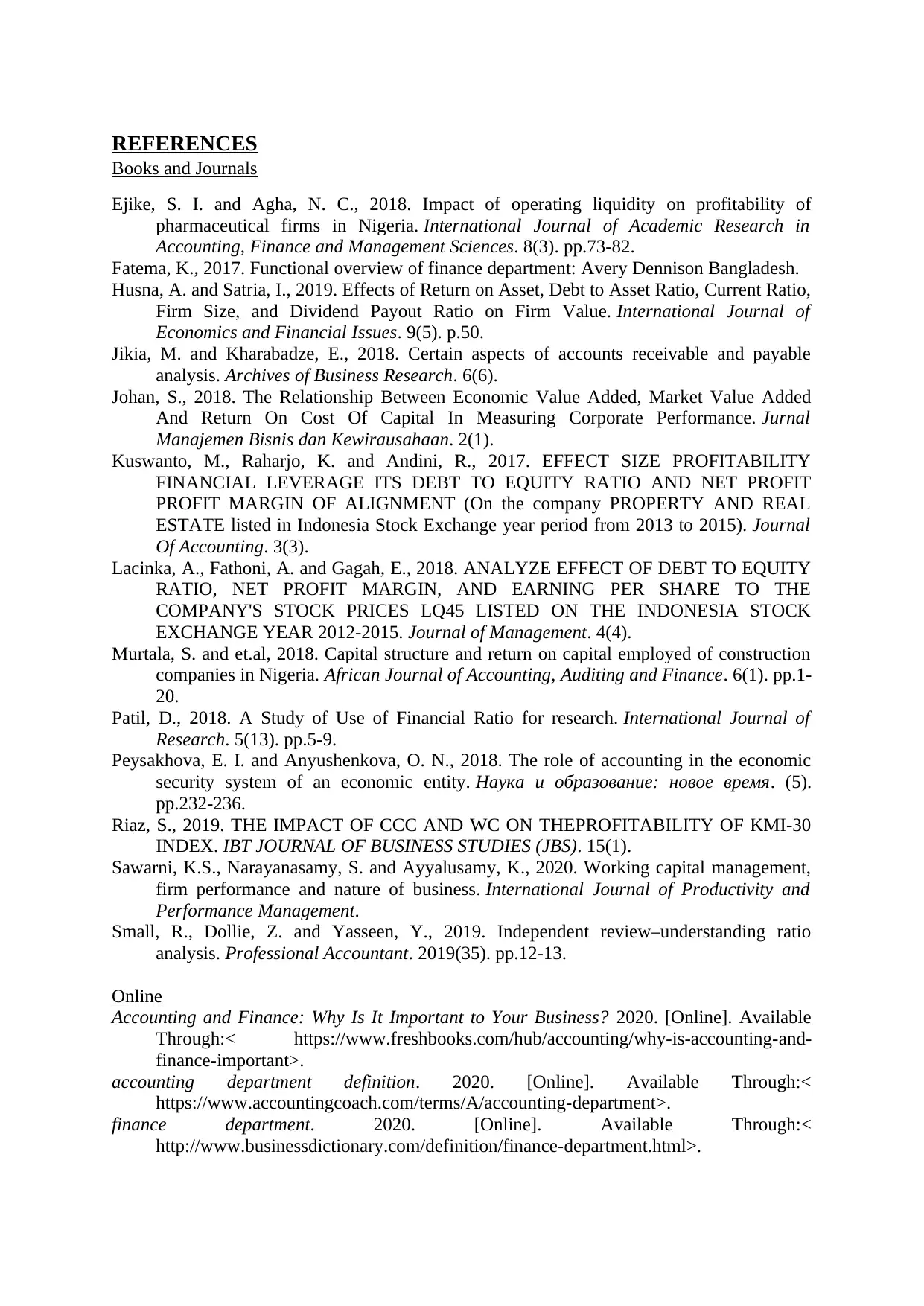
REFERENCES
Books and Journals
Ejike, S. I. and Agha, N. C., 2018. Impact of operating liquidity on profitability of
pharmaceutical firms in Nigeria. International Journal of Academic Research in
Accounting, Finance and Management Sciences. 8(3). pp.73-82.
Fatema, K., 2017. Functional overview of finance department: Avery Dennison Bangladesh.
Husna, A. and Satria, I., 2019. Effects of Return on Asset, Debt to Asset Ratio, Current Ratio,
Firm Size, and Dividend Payout Ratio on Firm Value. International Journal of
Economics and Financial Issues. 9(5). p.50.
Jikia, M. and Kharabadze, E., 2018. Certain aspects of accounts receivable and payable
analysis. Archives of Business Research. 6(6).
Johan, S., 2018. The Relationship Between Economic Value Added, Market Value Added
And Return On Cost Of Capital In Measuring Corporate Performance. Jurnal
Manajemen Bisnis dan Kewirausahaan. 2(1).
Kuswanto, M., Raharjo, K. and Andini, R., 2017. EFFECT SIZE PROFITABILITY
FINANCIAL LEVERAGE ITS DEBT TO EQUITY RATIO AND NET PROFIT
PROFIT MARGIN OF ALIGNMENT (On the company PROPERTY AND REAL
ESTATE listed in Indonesia Stock Exchange year period from 2013 to 2015). Journal
Of Accounting. 3(3).
Lacinka, A., Fathoni, A. and Gagah, E., 2018. ANALYZE EFFECT OF DEBT TO EQUITY
RATIO, NET PROFIT MARGIN, AND EARNING PER SHARE TO THE
COMPANY'S STOCK PRICES LQ45 LISTED ON THE INDONESIA STOCK
EXCHANGE YEAR 2012-2015. Journal of Management. 4(4).
Murtala, S. and et.al, 2018. Capital structure and return on capital employed of construction
companies in Nigeria. African Journal of Accounting, Auditing and Finance. 6(1). pp.1-
20.
Patil, D., 2018. A Study of Use of Financial Ratio for research. International Journal of
Research. 5(13). pp.5-9.
Peysakhova, E. I. and Anyushenkova, O. N., 2018. The role of accounting in the economic
security system of an economic entity. Наука и образование: новое время. (5).
pp.232-236.
Riaz, S., 2019. THE IMPACT OF CCC AND WC ON THEPROFITABILITY OF KMI-30
INDEX. IBT JOURNAL OF BUSINESS STUDIES (JBS). 15(1).
Sawarni, K.S., Narayanasamy, S. and Ayyalusamy, K., 2020. Working capital management,
firm performance and nature of business. International Journal of Productivity and
Performance Management.
Small, R., Dollie, Z. and Yasseen, Y., 2019. Independent review–understanding ratio
analysis. Professional Accountant. 2019(35). pp.12-13.
Online
Accounting and Finance: Why Is It Important to Your Business? 2020. [Online]. Available
Through:< https://www.freshbooks.com/hub/accounting/why-is-accounting-and-
finance-important>.
accounting department definition. 2020. [Online]. Available Through:<
https://www.accountingcoach.com/terms/A/accounting-department>.
finance department. 2020. [Online]. Available Through:<
http://www.businessdictionary.com/definition/finance-department.html>.
Books and Journals
Ejike, S. I. and Agha, N. C., 2018. Impact of operating liquidity on profitability of
pharmaceutical firms in Nigeria. International Journal of Academic Research in
Accounting, Finance and Management Sciences. 8(3). pp.73-82.
Fatema, K., 2017. Functional overview of finance department: Avery Dennison Bangladesh.
Husna, A. and Satria, I., 2019. Effects of Return on Asset, Debt to Asset Ratio, Current Ratio,
Firm Size, and Dividend Payout Ratio on Firm Value. International Journal of
Economics and Financial Issues. 9(5). p.50.
Jikia, M. and Kharabadze, E., 2018. Certain aspects of accounts receivable and payable
analysis. Archives of Business Research. 6(6).
Johan, S., 2018. The Relationship Between Economic Value Added, Market Value Added
And Return On Cost Of Capital In Measuring Corporate Performance. Jurnal
Manajemen Bisnis dan Kewirausahaan. 2(1).
Kuswanto, M., Raharjo, K. and Andini, R., 2017. EFFECT SIZE PROFITABILITY
FINANCIAL LEVERAGE ITS DEBT TO EQUITY RATIO AND NET PROFIT
PROFIT MARGIN OF ALIGNMENT (On the company PROPERTY AND REAL
ESTATE listed in Indonesia Stock Exchange year period from 2013 to 2015). Journal
Of Accounting. 3(3).
Lacinka, A., Fathoni, A. and Gagah, E., 2018. ANALYZE EFFECT OF DEBT TO EQUITY
RATIO, NET PROFIT MARGIN, AND EARNING PER SHARE TO THE
COMPANY'S STOCK PRICES LQ45 LISTED ON THE INDONESIA STOCK
EXCHANGE YEAR 2012-2015. Journal of Management. 4(4).
Murtala, S. and et.al, 2018. Capital structure and return on capital employed of construction
companies in Nigeria. African Journal of Accounting, Auditing and Finance. 6(1). pp.1-
20.
Patil, D., 2018. A Study of Use of Financial Ratio for research. International Journal of
Research. 5(13). pp.5-9.
Peysakhova, E. I. and Anyushenkova, O. N., 2018. The role of accounting in the economic
security system of an economic entity. Наука и образование: новое время. (5).
pp.232-236.
Riaz, S., 2019. THE IMPACT OF CCC AND WC ON THEPROFITABILITY OF KMI-30
INDEX. IBT JOURNAL OF BUSINESS STUDIES (JBS). 15(1).
Sawarni, K.S., Narayanasamy, S. and Ayyalusamy, K., 2020. Working capital management,
firm performance and nature of business. International Journal of Productivity and
Performance Management.
Small, R., Dollie, Z. and Yasseen, Y., 2019. Independent review–understanding ratio
analysis. Professional Accountant. 2019(35). pp.12-13.
Online
Accounting and Finance: Why Is It Important to Your Business? 2020. [Online]. Available
Through:< https://www.freshbooks.com/hub/accounting/why-is-accounting-and-
finance-important>.
accounting department definition. 2020. [Online]. Available Through:<
https://www.accountingcoach.com/terms/A/accounting-department>.
finance department. 2020. [Online]. Available Through:<
http://www.businessdictionary.com/definition/finance-department.html>.
Secure Best Marks with AI Grader
Need help grading? Try our AI Grader for instant feedback on your assignments.

1 out of 14
![[object Object]](/_next/static/media/star-bottom.7253800d.svg)


